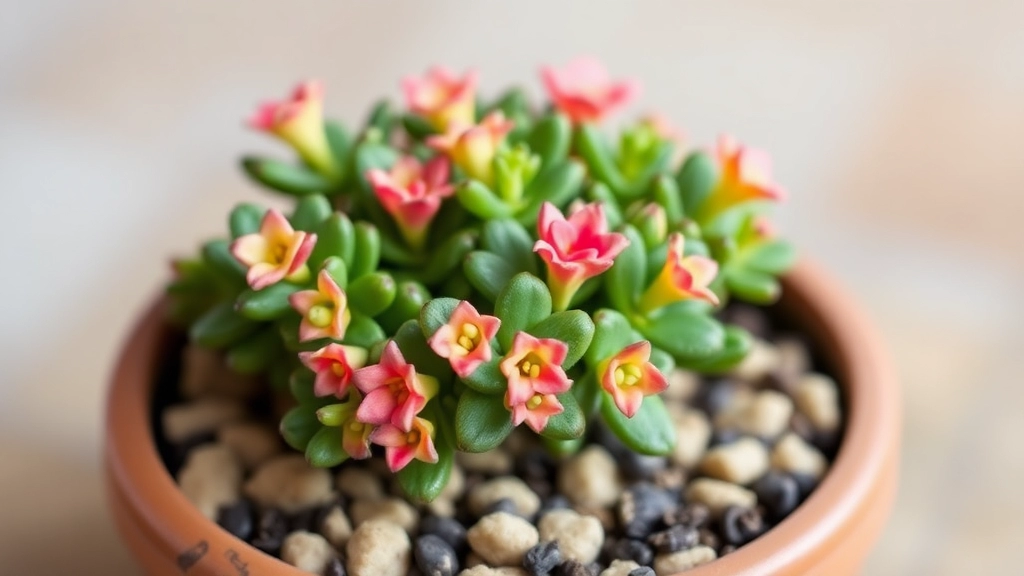Mastering Miniature Kalanchoe Care
Looking to master Miniature Kalanchoe Care? You’ve come to the right place. These charming succulents are a favourite among both novice and seasoned gardeners. I’ll guide you through the essentials, from light conditions to proper watering techniques, ensuring your mini kalanchoe thrives year-round.
Light Conditions
First off, let’s discuss light. Miniature kalanchoes love bright, indirect sunlight. Place them near a window where they can soak up ample light without getting scorched.
Temperature and Humidity
Next, don’t forget about temperature and humidity. These plants flourish in temperatures between 15°C and 24°C and prefer moderate humidity levels. Keep reading to discover more tips on watering, soil, and fertilizing to keep your mini kalanchoe in top shape.
Best Light Conditions for Miniature Kalanchoe
When it comes to caring for your Miniature Kalanchoe, one of the most pressing concerns is ensuring it receives the right amount of light. Many plant enthusiasts often wonder, “How much light does my Kalanchoe really need?”
Miniature Kalanchoes thrive in bright, indirect sunlight. Here’s a quick breakdown of what you should consider:
- Ideal Location: Place your Kalanchoe near a south-facing window where it can soak up ample light without being scorched.
- Duration: Aim for around 6 hours of light daily. If natural light is limited, consider using a grow light to supplement.
- Signs of Insufficient Light: If your plant starts to stretch towards the light or its leaves turn yellow, it’s time to reassess its position.
- Signs of Too Much Light: Brown, crispy leaf edges indicate that your Kalanchoe might be getting too much direct sunlight.
In my experience, finding that sweet spot can make all the difference in your plant’s health and blooming potential. For more detailed guidance, you might want to check out this ultimate guide on caring for Kalanchoe succulents. Additionally, understanding the causes and solutions for black spots on Kalanchoe leaves can help in maintaining your plant’s overall health.
Ideal Temperature Ranges and Humidity Levels for Miniature Kalanchoe
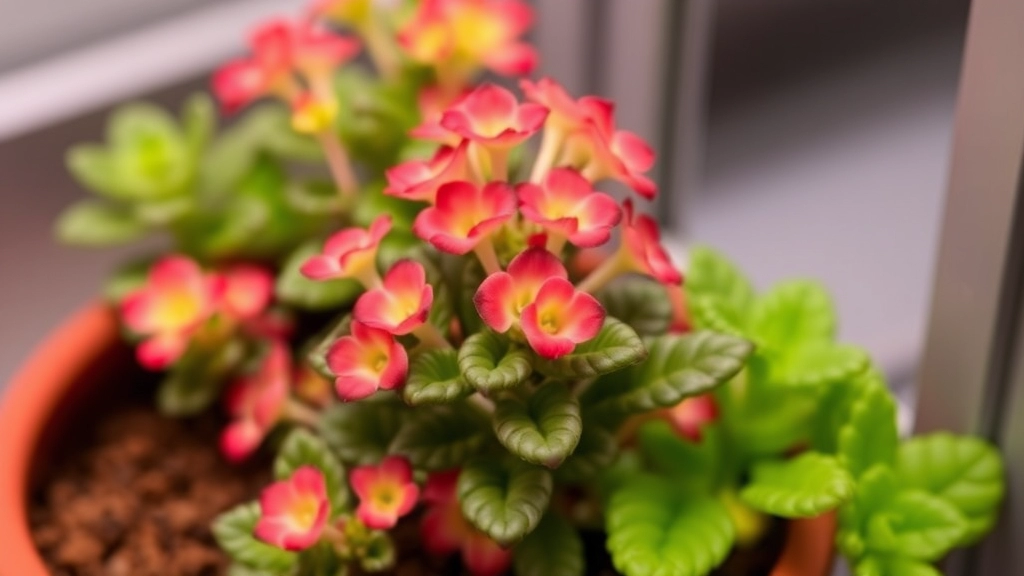
So, you’ve got your Miniature Kalanchoe and you’re wondering what the perfect environment is for it to thrive.
Well, let’s dive into the ideal temperature and humidity conditions that will keep your little green friend happy.
Temperature Ranges
Miniature Kalanchoe loves warmth, but it’s not a fan of extreme heat or cold.
- Optimal Daytime Temperature: 20-25°C (68-77°F)
- Nighttime Temperature: 15-18°C (59-65°F)
Keeping your plant within these ranges will help it flourish. If it gets too cold, you might notice the leaves dropping. Too hot, and it could start wilting or burning.
Humidity Levels
When it comes to humidity, Miniature Kalanchoe prefers a drier environment.
- Ideal Humidity: 40-60%
If your home is too humid, consider using a dehumidifier or placing your plant in a well-ventilated area.
Quick Tips:
- Avoid placing your Kalanchoe near drafty windows or heaters.
- If you live in a particularly humid area, let your plant dry out between waterings to prevent rot.
Watering Tips: Avoiding Overwatering and Underwatering
When it comes to caring for your miniature Kalanchoe, watering is a crucial aspect that can make or break your plant’s health. Many plant enthusiasts often grapple with the dilemma of how much water is just right.
Soil Requirements: Choosing the Right Well-Draining Mix
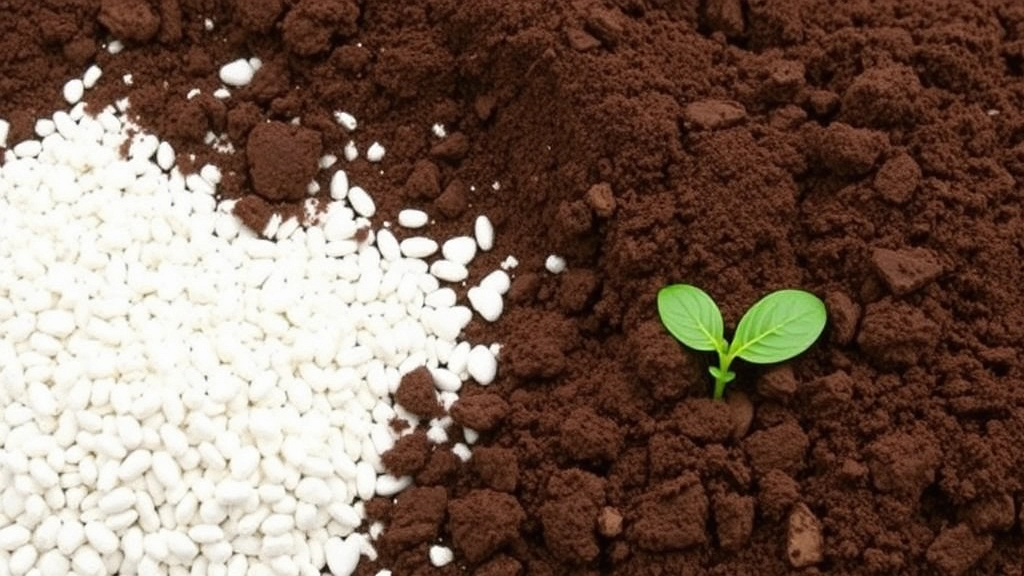
When it comes to nurturing your Miniature Kalanchoe, the right soil mix is crucial for its health and growth.
What Soil Should You Use?
Miniature Kalanchoe thrives in a well-draining soil mix that prevents waterlogging, which can lead to root rot. Here are key components to consider:
- Cactus Mix: A pre-made cactus or succulent mix is often perfect for Kalanchoe. These mixes typically contain sand, perlite, and peat, providing excellent drainage.
- DIY Soil Mix: If you prefer to create your own, combine:
- 50% potting soil
- 25% coarse sand
- 25% perlite or pumice
Why Well-Draining Soil Matters
Using a well-draining mix is essential because:
- It allows excess water to escape, preventing soggy roots.
- It promotes aeration, ensuring the roots receive enough oxygen.
- It mimics the plant’s natural habitat, where the soil is often sandy and dry.
Tips for Potting
When potting your Miniature Kalanchoe, consider these tips:
- Choose the Right Pot: Use pots with drainage holes to facilitate water flow.
- Layering: Add a layer of small stones or gravel at the bottom of the pot for additional drainage.
- Repotting: If you notice your plant is outgrowing its pot or the soil seems compacted, it might be time to repot with fresh soil.
Fertilizing Miniature Kalanchoe for Optimal Growth
When nurturing your Miniature Kalanchoe, the right fertilization strategy can make all the difference. You might wonder, “How do I ensure my plant gets the nutrients it needs without overdoing it?”
Understanding Nutrient Needs
Miniature Kalanchoes thrive on a balanced diet of nutrients. Here’s how to approach fertilizing:
Pruning and Deadheading: Encouraging Bushy Growth
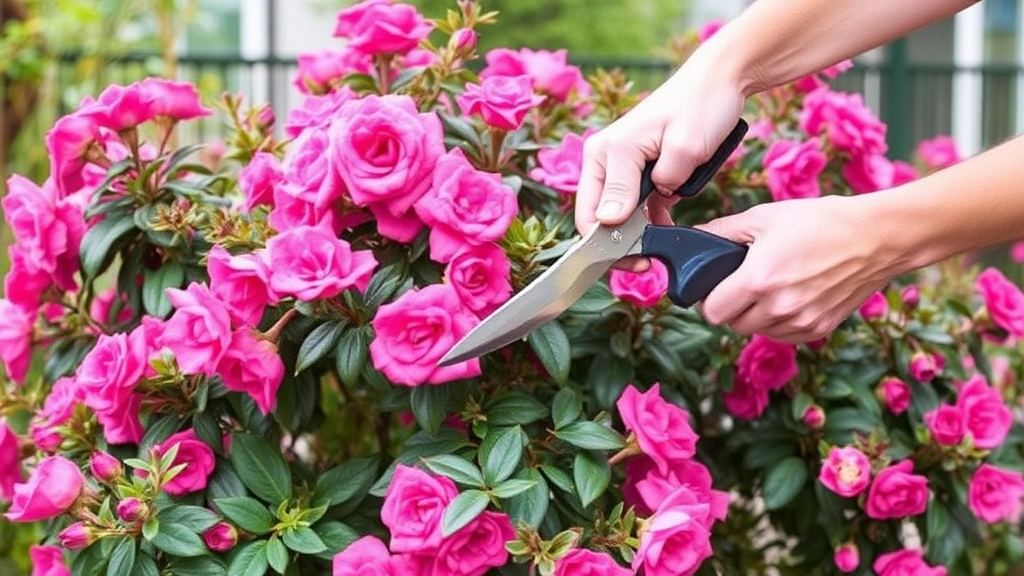
So, you’ve got your Miniature Kalanchoe looking all cute and healthy, but how do you keep it that way?
Pruning and deadheading are your best friends here.
Why Prune?
Pruning helps your plant grow bushier and fuller. It encourages new growth and keeps it looking vibrant. Plus, deadheading—removing spent flowers—means your plant can focus its energy on producing fresh blooms instead of wasting it on wilting ones.
When to Prune:
- After Blooming: Once the flowers have faded, it’s time to trim.
- Springtime: This is the ideal season to give your plant a good haircut.
How to Prune:
- Use clean, sharp scissors or pruning shears.
- Cut just above a leaf node to encourage new growth.
- Remove any leggy stems to promote a more compact shape.
Deadheading Tips:
- Pinch off spent flowers with your fingers.
- Make sure to remove any dead leaves too; they can attract pests.
Benefits of Pruning and Deadheading:
- Promotes bushy growth.
- Encourages more blooms.
- Keeps the plant healthy by removing dead or diseased parts.
Just think of it as giving your Mini Kalanchoe a little makeover every now and then.
How to Promote Blooming Throughout the Year
Are you struggling to keep your miniature Kalanchoe blooming consistently? You’re not alone. Many plant enthusiasts find it challenging to encourage their Kalanchoe to flower throughout the year. Fortunately, with a few focused strategies, you can enjoy a vibrant display of blooms.
Propagation Methods: Growing from Cuttings
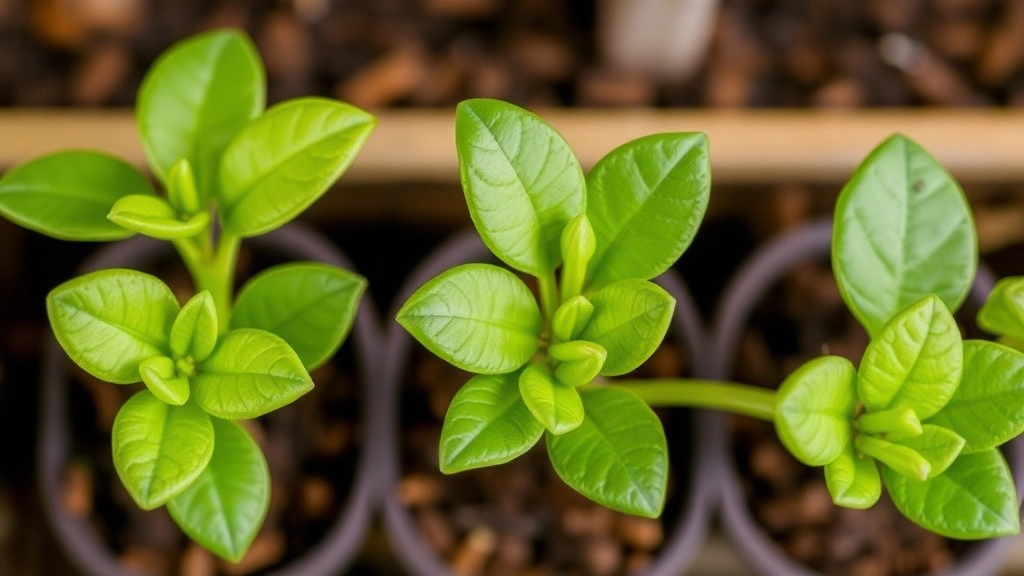
So, you’ve got a lovely Miniature Kalanchoe, and you’re wondering how to multiply that beauty? You’re in luck!
Propagation from cuttings is a straightforward way to grow new plants, and it can be really rewarding.
Why Choose Cuttings?
- Quick Results: You can see new growth in just a few weeks.
- Cost-Effective: No need to buy new plants; just use what you have.
- Fun Project: It’s a great way to engage with your plants and learn more about their care.
Steps to Propagate from Cuttings
- Select a Healthy Stem: Look for a healthy, plump stem that’s around 3-4 inches long.
- Make the Cut: Use clean, sharp scissors to snip the stem just below a leaf node. This is where new roots will sprout.
- Let it Callous: Place the cutting in a dry, warm spot for a day or two. This helps the cut end callous over and prevents rot.
- Prepare the Soil: Use a well-draining soil mix. You can even use a cactus mix for extra drainage.
- Plant the Cutting: Dip the cut end in rooting hormone (optional) and gently insert it into the soil.
- Water Sparingly: Give it a light watering, but avoid soaking the soil.
- Create a Humid Environment: Cover the pot with a plastic bag or a clear plastic dome to keep humidity high. Just make sure it doesn’t touch the leaves!
- Provide Bright, Indirect Light: Place your cutting in a spot with plenty of light but out of direct sun.
Care After Planting
- Monitor Moisture: Check the soil regularly. It should be slightly moist but not soggy.
- Remove the Cover: After a few weeks, once you see new growth, you can remove the plastic cover.
Common Pests and Diseases: Prevention and Treatment
As we dive deeper into caring for your Miniature Kalanchoe, it’s essential to address common pests and diseases that can affect its health. Recognising these issues early can save your plant from serious damage.
Dormancy Care: Managing Mini Kalanchoe During Rest Periods
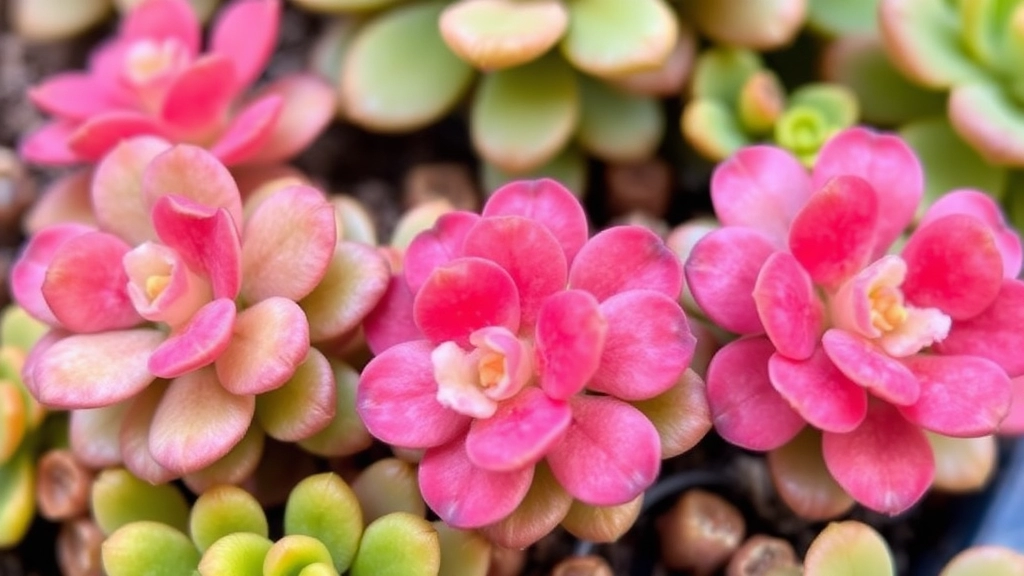
Have you noticed your Mini Kalanchoe slowing down? Maybe the leaves are a bit droopy, or the flowers have stopped blooming. This is totally normal!
During dormancy, usually in late autumn and winter, your plant takes a well-deserved break. Here’s how to keep it happy during this downtime.
Understanding Dormancy
- What is Dormancy?
It’s like a hibernation phase for your plant. Growth slows down, and it conserves energy.
Watering Tips
- Cut Back on Watering:
During dormancy, your Mini Kalanchoe needs less water.- Frequency: Water only when the top inch of soil feels dry.
- Signs of Overwatering: Yellowing leaves, mushy stems.
Lighting Needs
- Provide Indirect Light:
Keep it in a bright spot but avoid direct sunlight, which can stress the plant.- Ideal Location: Near a window with filtered light.
Temperature and Humidity
- Maintain a Stable Temperature:
Aim for 15-20°C (59-68°F).- Avoid Drafts: Keep it away from cold drafts or heat sources.
Fertilizing
- Hold Off on Fertilizer:
Your plant doesn’t need extra nutrients while it’s resting.- Resume After Dormancy: Start fertilizing again in spring.
Pruning and Care
- Minimal Pruning Needed:
Just remove any dead or yellowing leaves. This keeps your plant tidy without stressing it.
Signs of a Healthy Dormant Plant
- Leaves Staying Firm:
If the leaves are still firm and not shriveling, you’re doing great! - No New Growth:
A lack of new growth is normal; just let it be.
Preparing for Spring
- Watch for Changes:
As spring approaches, you’ll notice your Mini Kalanchoe waking up.- Increase Watering Gradually: Start watering more frequently as the days get longer.
Potting and Repotting: When and How to Refresh Your Plant’s Soil
Have you ever wondered when to repot your Miniature Kalanchoe or how to do it effectively?
Repotting is crucial for maintaining the health and vitality of your plant. It ensures that your Kalanchoe has ample space to grow and access to fresh nutrients.
FAQs on Miniature Kalanchoe Care
What are the ideal temperature ranges for Miniature Kalanchoe?
Miniature Kalanchoe thrives in warmth but not in extreme temperatures. The optimal daytime temperature is 20-25°C (68-77°F), while the nighttime temperature should be 15-18°C (59-65°F).
What humidity levels are best for Miniature Kalanchoe?
Miniature Kalanchoe prefers a drier environment with ideal humidity levels between 40-60%. If your home is too humid, consider using a dehumidifier or placing your plant in a well-ventilated area.
What type of soil is best for Miniature Kalanchoe?
A well-draining soil mix is crucial. You can use a pre-made cactus or succulent mix, or create your own by combining 50% potting soil, 25% coarse sand, and 25% perlite or pumice.
Why is well-draining soil important for Miniature Kalanchoe?
Well-draining soil prevents waterlogging, which can lead to root rot. It also promotes aeration, ensuring the roots receive enough oxygen, and mimics the plant’s natural habitat.
How often should I prune my Miniature Kalanchoe?
Prune your Miniature Kalanchoe after blooming or during springtime. This encourages bushier growth and keeps the plant healthy.
What are the steps to propagate Miniature Kalanchoe from cuttings?
- Select a healthy stem around 3-4 inches long.
- Use clean, sharp scissors to snip the stem just below a leaf node.
- Let the cutting callous over for a day or two.
- Plant the cutting in well-draining soil.
- Water sparingly and create a humid environment.
- Provide bright, indirect light.
How should I care for my Miniature Kalanchoe during dormancy?
During dormancy, usually in late autumn and winter, reduce watering and avoid fertilizing. Keep the plant in a bright spot with indirect light and maintain a stable temperature of 15-20°C (59-68°F).
How can I tell if my Miniature Kalanchoe is healthy during dormancy?
If the leaves remain firm and not shriveled, and there’s no new growth, your plant is likely healthy. Just remove any dead or yellowing leaves to keep it tidy.
References
-
House Plants Expert: Kalanchoe
-
Gardening Know How: Kalanchoe Care
-
The Spruce: How to Grow Kalanchoe
